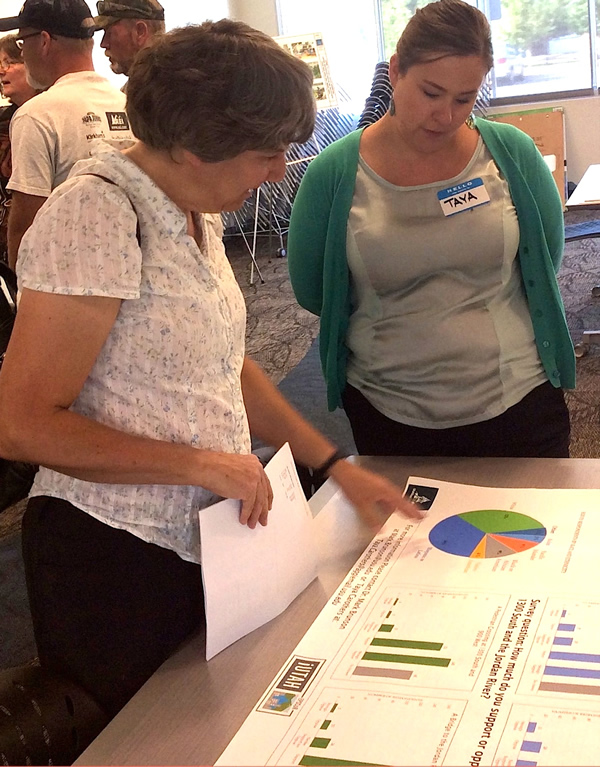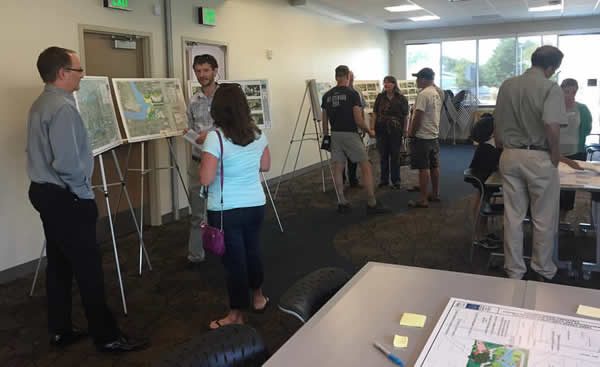News Article
December 6, 2016
Engaging Neighborhoods in Survey Results
Last summer, nearly 400 people on Salt Lake City’s west side were asked about their connections to the Jordan River and the parklands alongside the river. Bilingual surveys were distributed in public places such as grocery stores, libraries, parks, and community events. Students involved in iUTAH Undergraduate Research Fellows (iFellows) Program, Cynthia Elliott and Luis Vidal, conducted the survey using iPads and interacting directly with residents.
Mark Brunson, professor in Utah State University’s Department of Environment and Society and the USU Ecology Center, and Taya Carothers, PhD student at USU, jointly developed the survey. They were aided in this process by collaborators in Salt Lake City’s open space lands program, Lewis Kogan and Tyler Murdock; and the design consultant for the Three Creeks Confluence project.
“As iUTAH’s director of education, outreach, and diversity, I have long wanted to do something that engaged the diverse neighborhoods on Salt Lake City’s west side and could be used to benefit people in those communities,” said Brunson. The idea for the study started at meeting led by Brian Tonetti, the executive director of the Seven Canyons Trust, held in fall 2015. While talking about how the Glendale neighborhood felt about daylighting (freeing buried rivers and streams) that currently run through Salt Lake City, it became clear that getting input from a broad diversity of neighborhood residents was challenging. This seemed like an opportunity to combine Carothers’s research on environmental justice and water with more general questions that might serve a variety of community projects in the area, such as the Glendale project.
After the survey results were collected and data formulated, iUTAH’s cyberinfrastructure team used visualization tools to help make the information accessible and easy to understand. This online tool, the survey data viewer, is publicly available and provides a simple interface to communicate the results of surveys to stakeholders, participants, and the general public. Information on this process can be found here. This information has been useful in presentations to make the results more interesting and applicable to specific groups.
“We found it to be extremely helpful because it is very visual,” said Carothers, who is also an iUTAH Graduate Research Assistant. “As a visual representation, it shows people what the data look like, by the size of the circle as a heat map, and then people can really visualize support or concern about a specific topic.“ It has been used in meetings with neighborhood council groups to show the data and to answer questions. This audience often lacks background information about the survey and mainly wants to know how it relates to them personally. The data viewer allows the presenter to look up answers to the specific area-related questions that people have, and use it as a tool to start a discussion.
“As a researcher who studies human-environment interactions, it’s been fascinating to learn about the different ways that individuals are connected to the Jordan, a very urban river that has a reputation more for impaired water quality than for recreation opportunities,” said Brunson. The link to the data survey has also been sent to specific stakeholders for use in proposal writing for future grants and research. The weed puncture vine, a plant covered with spines sharp enough to flatten bicycle tires, was identified by SLC residents as one of their larger concerns along the river and parkway. In response to this concern, the Open Space Lands program, Natural History Museum of Utah, and Brunson are collaborating on a proposal that could lead to a new citizen science project to address this issue directly.
This project demonstrates the multi-dimensional collaborations and partnerships that iUTAH, an interdisciplinary research and training program aimed at strengthening science for Utah’s water future, fosters in the state.
For downloadable article, along with quick reads version, visit the full article…


« Back to list of all news articles


